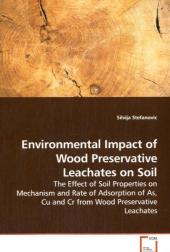 Neuerscheinungen 2013Stand: 2020-01-07 |
Schnellsuche
ISBN/Stichwort/Autor
|
Herderstraße 10
10625 Berlin
Tel.: 030 315 714 16
Fax 030 315 714 14
info@buchspektrum.de |

Silvija Stefanovic
Environmental Impact of Wood Preservative Leachates on Soil
The Effect of Soil Properties on Mechanism and Rate of Adsorption of As, Cu and Cr from Wood Preservative Leachates
2013. 196 S. 220 mm
Verlag/Jahr: VDM VERLAG DR. MÜLLER 2013
ISBN: 3-639-06357-0 (3639063570)
Neue ISBN: 978-3-639-06357-8 (9783639063578)
Preis und Lieferzeit: Bitte klicken
Depending on the physical and chemicalcharacteristics of soil, adsorption of inorganiccomponents of leachates from preservative treatedwood can limit movement of contaminants to othercompartments (soil as a sink) and reduce their toxiceffect by limiting bioavailability. Estimatedadsorption maxima of Cu CCA in organic and clay soilswere the same or higher than for Cu ACQ and Cu CA.The presence of preservative components in the soildecreased the yield and increased their accumulationin ryegrass. Uptake of As, Cu, and Cr in rye grasswas just as well predicted by total soil content aswith any of the bioavailable estimates. ACQ leachateshowed higher toxicity to germination of ryegrassseeds and Daphnia magna toxicity; it had a lowereffect on ryegrass growth than CCA leachate. Reactionof ACQ leachate with sandy soil components resultedin reduced toxicity to Daphnia magna. None of thecontaminated soils had a measurable effect onearthworms, although there was some preservativeuptake in the worms. CCA and ACQ had similar effectson soil microflora/fauna respiration. CA leachate hadlower toxicity to Daphnia magna and similar toxicityto other organisms as ACQ.
Depending on the physical and chemical characteristics of soil, adsorption of inorganic components of leachates from preservative treated wood can limit movement of contaminants to other compartments (soil as a sink) and reduce their toxic effect by limiting bioavailability. Estimated adsorption maxima of Cu CCA in organic and clay soils were the same or higher than for Cu ACQ and Cu CA. The presence of preservative components in the soil decreased the yield and increased their accumulation in ryegrass. Uptake of As, Cu, and Cr in rye grass was just as well predicted by total soil content as with any of the bioavailable estimates. ACQ leachate showed higher toxicity to germination of ryegrass seeds and Daphnia magna toxicity; it had a lower effect on ryegrass growth than CCA leachate. Reaction of ACQ leachate with sandy soil components resulted in reduced toxicity to Daphnia magna. None of the contaminated soils had a measurable effect on earthworms, although there was some preservative uptake in the worms. CCA and ACQ had similar effects on soil microflora/fauna respiration. CA leachate had lower toxicity to Daphnia magna and similar toxicity to other organisms as ACQ.


